| Jul-28-08 | | Cactus: A brilliant game by the 'drawing master'. |
|
| Nov-12-08 | | vonKrolock: First game of the match
<10.♘bd2> Another possibility is 10.♕b3 0-0 11.♘bd2 etc - in on of his articles from 1902 in the magazine "Deutsche Schachzeitung", Schlechter pointed out now following line: <11.♘fd2? ♘xf2! 12.♔xf2 ♗h4+ 13.g3 f4! 14.♔g2 fxg3 etc - good for black, and well documented - but wait, have a look at Ljubojevic vs S Makarichev, 1975 |
|
Mar-01-17
 | | offramp: The link given ^ by <vonKrolock> has been altered to Ljubojevic vs S Makarichev, 1975. |
|
Sep-07-22
 | | offramp: Well, everyone will have to wait to <have a look at Ljubojevic vs S Makarichev, 1975>, IF that game still exists. Here is a modern incarnation of the Petroff Hurricane, V Zarubitski vs Fridman, 2020. At least that REALLY does exist, eh, <VonKrolock>. In this game Schlechter SHLELLACKED 🧡👌 his powerful opponent. The Petroff Defence has that quality do that, if Black has the opportunity. Capablanca was White but Kolisch could have jobbernowl his famed Cuban foe (ie, Capablanca).
Capablanca vs Kostic, 1919. |
|
May-09-25
 | | KEG: Schlechter annihilated Janowski in this (potentially 14-game) match, winning the first four games, drawing game five, and then winning game six before Janowski took his only full point in Game 7. Schlechter then drew Games 8 and 9 and won game 10, thus clinching the match. How to explain this debacle for Janowski? Schlechter was a fine and formidable match player. He later drew a short match with Teichmann, then drew a 10-game match with Lasker (coming perilously close to taking the World Championship), and in 1911 drew a 16-game match with Tarrasch. The only classical match Schlechter lost in his life was his 1918 match against Akiba Rubinstein. That match was played in the year of Schlechter's death and at a time when Rubinstein was one of the top players in the world. Even then, Rubinstein had to come from behind to win by one game (a 6-game match). So one explanation is that Schlechter was simply a much better match player than Janowski (their tournament credentials with more closely aligned, with Schlechter winning a strong tournament at Hanover directly after getting smoked in this match). But Schlechter and Janowsky had played an earlier match in 1896 which was drawn with two victories apiece in seven games (a weird format in which the players agreed the match would be considered drawn if they were tied after 7 games). The real explanation in my view is that Janowski played like a luntatic in this 1902 match, apparently expecting Schlechter to wilt against his aggressive style. This, of course, hardly likely given Schlechter's calm and precise play. A bit of a curiosity this match. The first game gave a hint of what was to come, Janowski erred on his 12th move, losing a pawn to a clever combo, and then falling to pieces and getting crushed in 23 moves. In fairness to Janowski, he may have already have been lost after his move 12 blunder: 1. e4 e5
2. Nf3 Nf6
The Petroff. Schlecter reverted to the Ruy Lopez as Black in Games 5, 7, and 9, winning once (Game 7) and drawing the other two times. (Schlechter played the French Defense in Game 3). 3. Nxe5 d6
4. Nf3 Nxd4
5. d4 d5
6. Bd3 Nc6
7. 0-0 Be7
So far, pretty standard stuff.
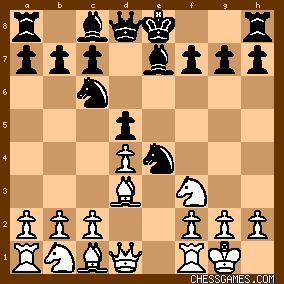
click for larger view8. Re1
8. c4 is a bit more usually played, but the text is certainly unobjectionable. 8... Bg4
"!"--MCO 13.
I have no idea why MCO-13 assigns a "!" to this normal move in this opening. It certainly served Schlechter well in this game, but could hardly have been a surprise for Janowski. 9. c3 f5

click for larger view10. Nbd2
The introductory essay on this match agrees with Alapin that the text was "weak." In fact, the move is given as best in MCO-13. Either it or 10. Qb3 look fine to me. Janowski's problems began with his 11th move (not to mention his move 12 blunder). 10... 0-0
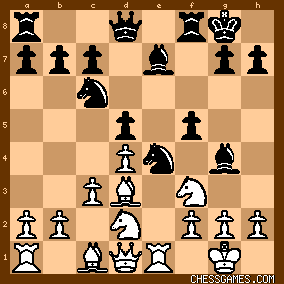
click for larger viewSo far, contrary to Alapin, I see nothing much wrong with Janowski's game. With the more usual 11. Qb3, he even appears to get a small edge. I will discuss Janowski's rapid collapse from the above-diagrammed position in my next post on this game. |
|
May-11-25
 | | KEG: Post II
11. Nf1?
Clearly inferior to the usual 11. Qb3.
The text may have been a reflex move by Janowski, since the idea of Nb1-d2-f1 is a normal plan in the Ruy Lopez. Here, however, the text forfeits any advantage Janowski might have derived as White in this opening. But though the move is inferior, White still retains a tenable albeit slightly inferior game. At least for now. 11... Bd6
A threat that should hardly have led to the collapse of the White position, given the current status of the game after 11...Bd6 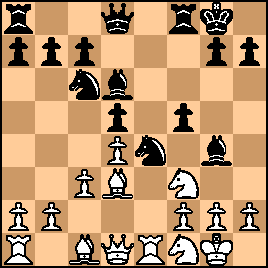
click for larger view12. Ne3??
Completely overlooking Schlechter's threat. My guess is that Janowski, who as Black would surely have seen the crushing reply--could not bring himself to believe that the usually positional Schlechter would spring a piece sacrifice on him just out of the opening. White would have an entirely satisfactory--even if in no way superior--game after 12. Be2 or 12. Ng3 or 12. Qb3 or even 12. h3. But now the position was: 
click for larger viewBlack to play.
12... Bxh2+ !

click for larger viewJanowski was now in trouble. But was he lost? This is not clear to me. Had Karpov been playing White, he would surely have hung tough with 13. Kf1! Bf4 14. Qb3 [or maybe even 14. Kg1] BxN (e3) 15. BxB Na5 15. Qa3 [or 15. Qc2] with a difficult but not necessarily hopeless game. But Janowski remained unable to believe that Schlechter could actually defeat HIM with a piece sacrifice, and so he played the catastrophic: 13. KxB?
Now the roof fell in on the over-arrogant Janowski: 13... Nxf2
The only move, but a winning one. This left:

click for larger viewThe game is now probably beyond salvage, but Janowski--for reasons I cannot begin to fathom--decided to give up his Queen [rather than trying a rear-guard defense with 14. Qd2 or 14. Qc2. But after Janowski's actual move: 14. Bxf5??
The always careful Schlechter knew what to do now: 14... NxQ
15. BxB

click for larger viewThe always precise Schlechter was not going to go wrong here: 15... RxN!
Now the Black Queen can enter the White position on h4 and the game is definitely over, though Janowski chose to play on for a while (perhaps not wanting as White to lose in fewer than 20 moves]. 16. RxN Qh4+

click for larger viewEven Magnus Carlsen could not have offered any resistance to Schlechter from here. But Janowski not only chose to play on, but managed to find ways to lose with even more celerity than was necessary, as I will discuss in my next post on this game. |
|
May-11-25
 | | KEG: Post III
17. Bh3
This gets White mated faster than 17. Kg1; not that the latter move would have any prospect of saving the game. 17... Raf8
Cute, though just about anything wins here for Black. After the text, the position was: 
click for larger view18. gxR
Again selecting the fastest way to get mated.
18... Rxf3
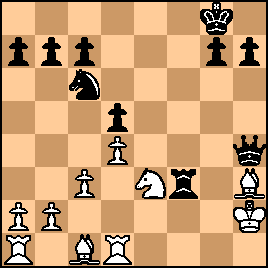
click for larger view19. Rf1
Yet again hastening the end.
19... RxB+
19...Rg3 is an even easier way to finish off the hopeless White position. 20. Kg1 Rh1+

click for larger view21. Kg1 Qh3+
22. Kf2 Rh2+
23. Ke1 Qh4+
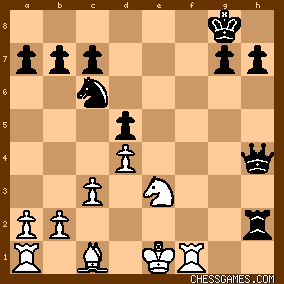
click for larger viewHere Janowski resigned his hopeless position. Not a moment too soon. 0-1 |
|
May-21-25
 | | KEG: Correction:
In my first post on this game, I erroneously stated that in Games 5, 7, and 9 (the other times in the match in which Janowski was on the White side of a double King's pawn opening) Schlechter played the Ruy Lopez, winning Game 7 and drawing the other two. This is wrong. In those games (as opposed to here) Schlechter played 2...Nc6 (instead of employing the Petroff) and it was JANOWSKI who played the Ruy Lopez and who won Game 7 and drew the other two. Apart from those three games, Schlechter yielded a draw in Game 8 (in which he had White) and won all of the other games of this one-sided match. |
|
|
|
|





































